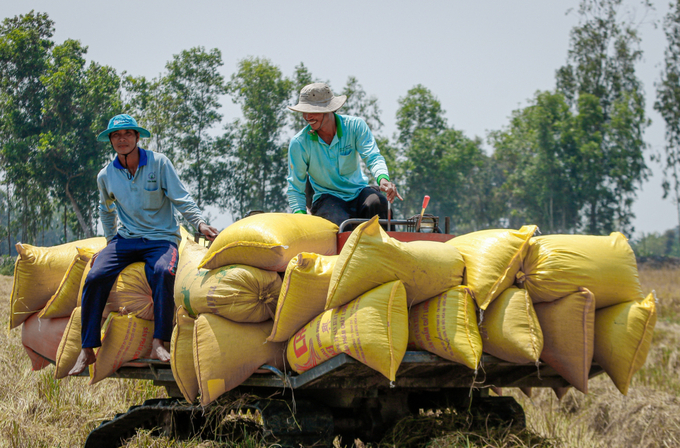November 28, 2025 | 06:24 GMT +7
November 28, 2025 | 06:24 GMT +7
Hotline: 0913.378.918
November 28, 2025 | 06:24 GMT +7
Hotline: 0913.378.918

Vietnamese rice harvest in Soc Trang province. Photo: Nguyet Nhi.
The Vietnam Trade Office in the Philippines has just announced the latest data. Accordingly, Vietnamese rice is leading the market in the Philippines - Vietnam's largest rice export partner for many years.
In June this year, the Philippines reduced the rice import tax from 35% to 15%, applicable until 2028, and is expected to increase the import volume from 4 million to 4.5 million tons. The opportunity for Vietnamese rice in the year's second half is assessed to be very open.
However, although the opportunity to export rice is expanding, many businesses still need to be cautious due to high input prices and the impact of storms and floods that could reduce rice supply at the end of the year. The year-end market is expected to fluctuate, contributing to businesses' concerns when signing new export contracts.
The Vietnam Trade Office in the Philippines recommends businesses balance costs to offer competitive prices and maintain market share. At the same time, the Ministry of Industry and Trade, the Embassy, and the Vietnam Trade Office will also support businesses in trade promotion activities, advertising, and improving product quality to increase export value.
Last year, Vietnam exported more than 3 million tons of rice to the Philippines, down 3% compared to 2022. However, thanks to high prices, export turnover reached USD 1.75 billion, up 17.6% compared to the previous year.
According to the Ministry of Agriculture and Rural Development (MARD), the Philippines, Indonesia, and Malaysia are the three largest markets for Vietnamese rice exports. In the first seven months of 2024, Vietnam exported 1.98 million tons of rice to the Philippines, accounting for 38.2% of Vietnam's total rice exports.
Indonesia ranked second, with Vietnam's rice exports to this market reaching 830,000 tons. The Indonesian market accounts for 16% of our country's rice exports.
Malaysia ranked third. In the first seven months of 2024, this country imported more than 461,000 tons of rice from Vietnam, accounting for 10.2% of Vietnam's total rice exports.
Translated by Huong Giang

(VAN) China’s cooking oil is suddenly flooding into India. It all comes down to a soybean surplus that Beijing doesn’t quite know what to do with.

(VAN) An Giang promotes supply-demand connections, standardizes quality and builds value chains, creating a foundation for sustainable bird’s nest development and aiming to expand exports.
/2025/11/24/5339-4-nongnghiep-075331.jpg)
(VAN) Recently, the conference on 'Sustainable Fisheries Linkage Chain - Tilapia for Export' took place in Tien Hai commune, Hung Yen province.
/2025/11/21/4309-2-153400_128.jpg)
(VAN) Green and low-emission rice is paving the way for Vietnamese rice to enter high-end markets, marking the beginning of a transformation journey toward greening and elevating the national rice brand.

(VAN) ‘Right to Win’ outlines a national action plan that shapes a new vision for Viet Nam’s agriculture in an era of renewal and global integration.

(VAN) Lam Dong’s farmed sturgeon output this year is expected to reach 2,300 tons, worth VND 450 billion, affirming the brand’s position on the market.

(VAN) A surge in Ukrainian egg exports, largely driven by soaring sales to the UK over the last few years, has notably pushed up egg prices on the domestic market.